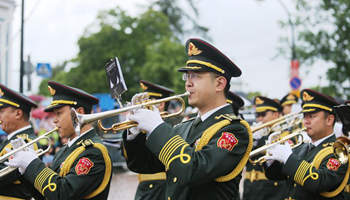SAN FRANCISCO, Aug. 4 (Xinhua) -- Researchers with University of California have worked to find how sunflowers not only pivot to face the sun as it moves across the sky during the day, but they also rotate 180 degrees during the night to greet the morning sun.
Their findings include: sunflowers have linked their internal clock genes to stem growth, so that the eastern side of the stem elongates more than the western side during the day, turning the stem and flower westward to track the transiting sun. At night, the western side grows faster, turning the flower head back east in time to capture the rays of the rising sun.
And, once the plant has grown to maturity, as researchers write in a paper published Thursday in the journal Science, the clock genes turn off this differential growth, leaving the flower facing east to gather the heat of the morning sun and provide a warm platform for pollinating bees.
"We show that these roles impact how much the plants grow and how well they attract pollinators, thus demonstrating that this regulation of light-responsive growth by the clock is likely an (evolutionary) adaptation," said co-author Benjamin Blackman, an assistant professor of plant and microbial biology at UC Berkeley.
Working with Blackman at the University of Virginia and, starting this year, at UC Berkeley, UC Davis postdoctoral fellow Hagop Atamian staked plants so that they couldn't move or turned potted plants daily so that they were facing the wrong way. They found that they could disrupt the ability to track the sun, and sunflowers staked so they can' t move have less biomass and leaf area than those that do, they found.
Blackman noted that many plants orient their leaves toward the sun and turn back at night, but few act like the sunflower to turn the entire stem. This behavior of sunflowers was described by scientists as far back as 1898, but "before our experiments, few studies - the latest more than 50 years ago - had assessed how sunflowers returned at night, and they had suggested some internal 'habit' was involved but did not directly implicate the clock."
The team identified a number of genes that were expressed at higher levels on the sunward side of the plant during the day, or on the other side at night. There are two growth mechanisms at work in the sunflower stem: the first sets a basic rate of growth for the plant, based on available light; the second, controlled by the circadian clock and influenced by the direction of light, causes the stem to grow more on one side than another, and therefore sway east to west during the day.
They also investigated why mature sunflowers always face east, and found that east-facing sunflowers heated up more quickly in the morning - and also attracted five times as many pollinating insects. Again, the circadian clock helps lead to the eastward orientation of sunflower heads when they stop tracking as they bloom, Blackman said.
"It's the first example of a plant's clock modulating growth in a natural environment, and having real repercussions for the plant," added Stacey Harmer, a professor of plant biology at UC Davis and the paper's senior author.
"I expect that future work in those systems will find parallel results to ours if the movement is mediated by differential growth," Blackman said. "The more general point, that one of the circadian clock's adaptive functions is to regulate the timing and strength of growth responses to environmental signals, is one that I think will apply to a broad range of traits and species."










